San Luis Rey Mission Church (CA Mission #18)
Introduction
Text-to-speech Audio
Images
The church as it appeared in 1890. This mission features the only wooden cupola on any of the 21 California missions.
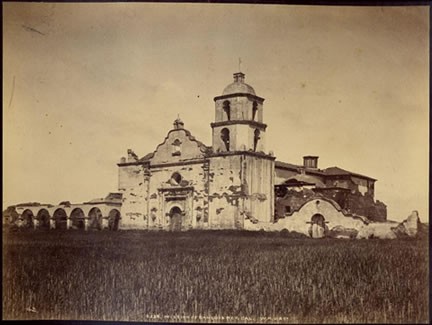
The restored church as it appears today. The design is notable for its Moorish architectural influences, uncommon among the California missions.
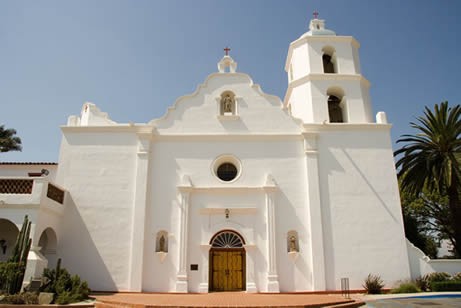
One of two markers noting the encampment of the Mormon Battalion at the mission. The Battalion was organized by the Latter Day Saints Church in the hopes that it would lead to more support from the U.S. government.
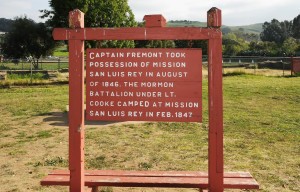
Second marker concerning the Mormon Battalion at the mission. Mormon communities had recently fled violent persecution in Missouri and Iowa, but had not obtained permission to settle in a permanent homestead anywhere in the United States.
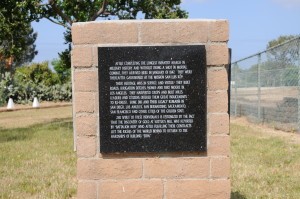
San Luis Rey in 1827, as sketched by French sea-captain Duhaut-Cilly. The captain was a former officer in Napoleon's navy, now a merchant captain attempting to open the French fur trade in the Pacific. He sailed around the world from 1826-1829.
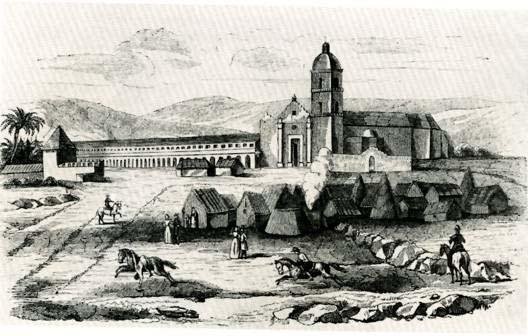
The title page of Duhaut-Cilly's "Voyage Around the World." The picture at left is a sketch of a California port in 1827. He was so fascinated by the missions that over 500 pages are dedicated to California.
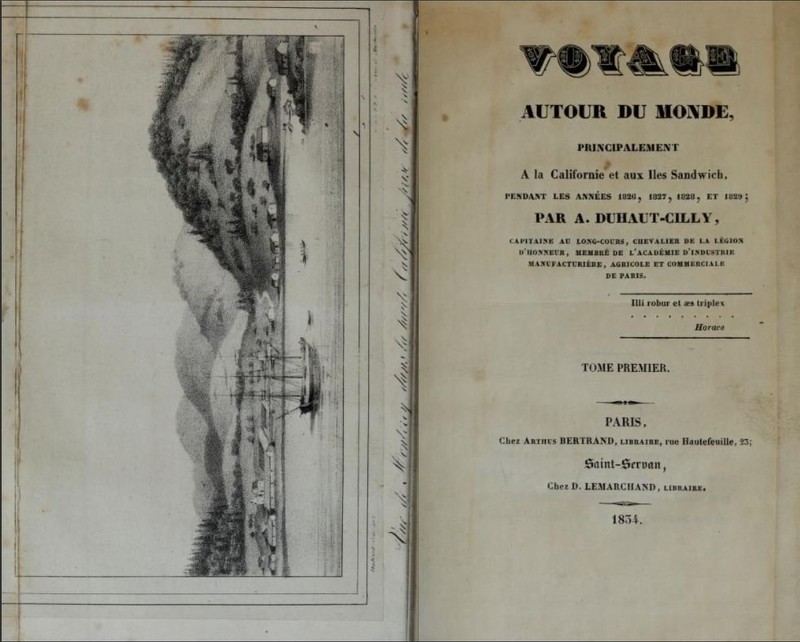
The present-day restored church interior. San Luis Rey features the only surviving cruciform (cross-shaped) structure among the missions, as many original mission churches suffered from repeated earthquakes and had to be rebuilt in the 1800s.
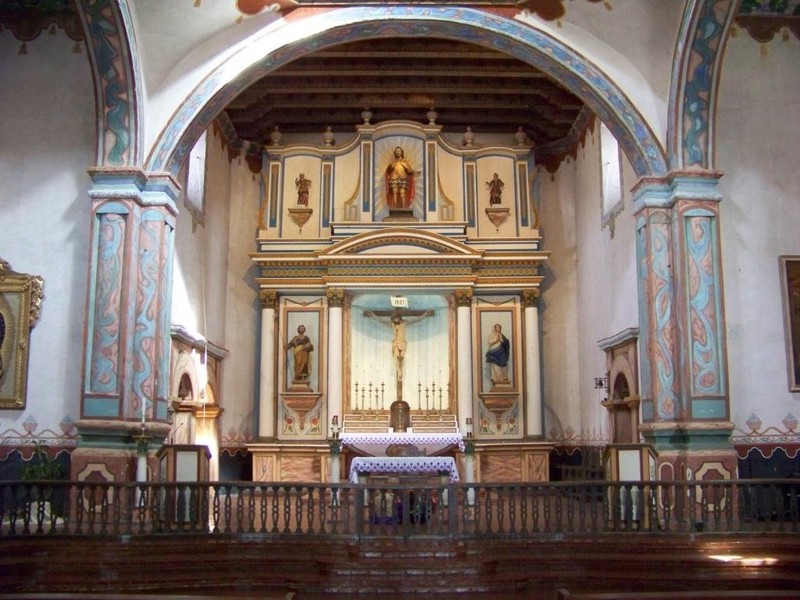
Museum exhibits detail mission life. The garb of one of the Franciscan friars is displayed here, which starkly contrasted with the minimal clothing of the tribes native to California. Courtesy of Mission San Luis Rey.

A colonnade over 500 feet long bordered one side of the quadrangle. Little remains today.
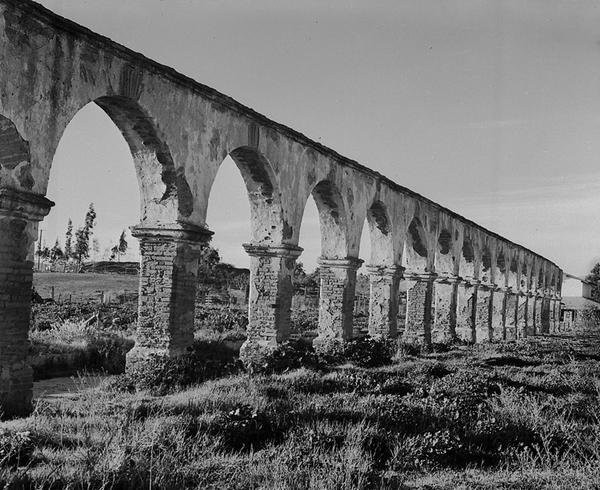
California's first pepper tree, orginally brought as a seed from Peru, still stands in the courtyard. The tree proved so popular and pervasive in the state that it was renamed the "California Pepper Tree." Courtesy of Lets Go See It.
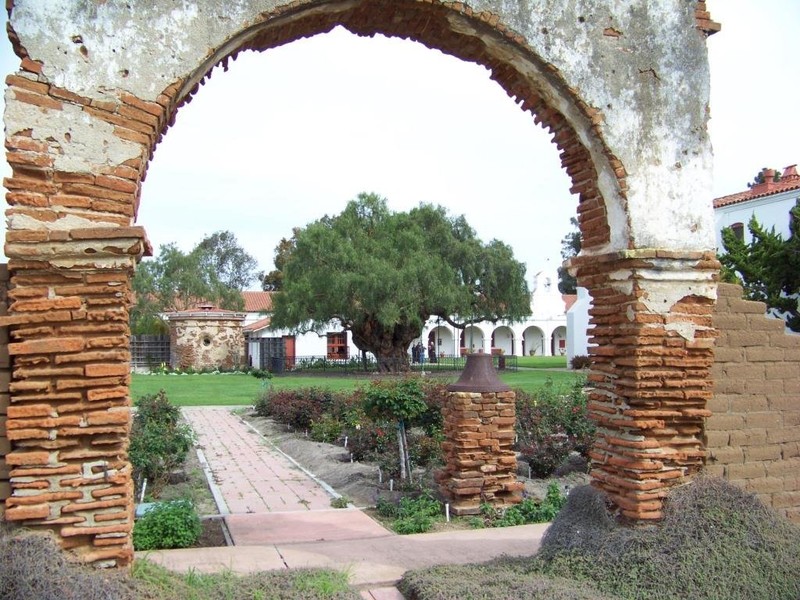
The outdoor lavanderia brought water to the courtyard via aqueducts. The elaborate system, which allowed women to wash clothes in charcoal-purified water, was excavated by archaeologists and students in the 1950s. Courtesy of Lets Go See It.
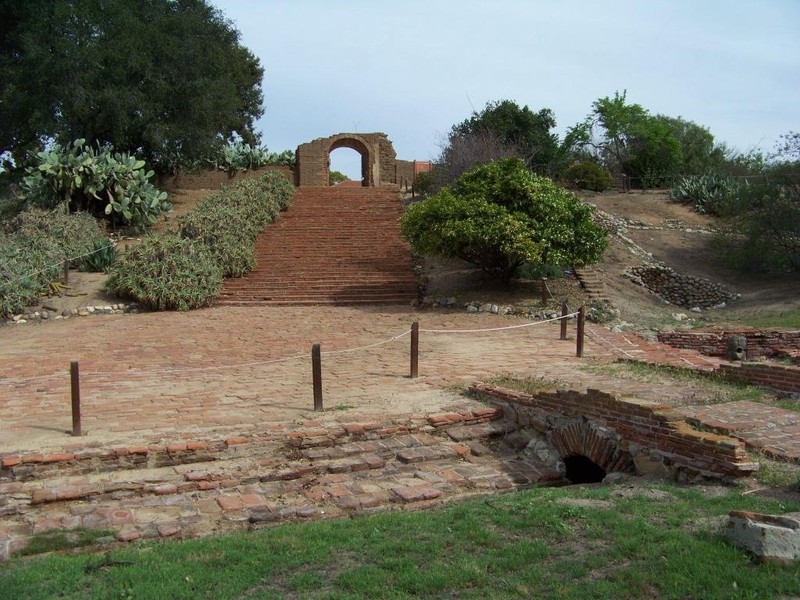
Elevation plans from the National Park Service and Works Progress Administration, which performed work on the site in the 20th Century.
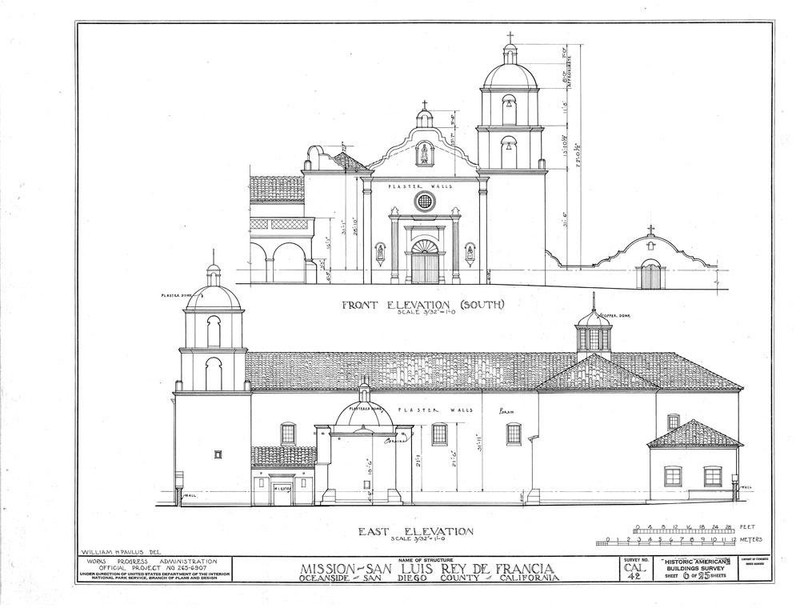
Backstory and Context
Text-to-speech Audio
In 1769, when the Franciscan order sent padres north from the Spanish territories in Mexico and established the first mission in "Alta California,” they were among the first Europeans to inhabit the area. Due to the vast distance between Europe and the New World, Spain would be sending no armies or colony ships; the Franciscans were tasked with claiming this new land by Christianizing the native peoples and creating independent settlements that owed their fealty to the Spanish crown. At the time of the Spanish arrival, the indigenous population of the San Diego area alone is estimated at 10,000.
On June 13, 1798, Mission San Luis Rey de Francia became the eighteenth mission in a chain stretching northward 600 miles to the San Francisco Bay. Along with San Juan Capistrano, this new mission tightened the link between San Diego and San Gabriel Arcangel in Los Angeles, the latter of which capped the only overland route between Alta California and Spain's holdings in Sonora--a crucial highway for supplies and travelers through the deserts and mountains of northern Mexico.
Named after Louis IX, the medieval Crusader King of France, Mission San Luis Rey de Francia was founded by the second president of the California missions, Father Fermin de Lasuen. Following standard procedure, two padres--Fathers Antonio Peyri and Jose Faura--were left in charge of the new enterprise, but it is Peyri with whom the mission became synonymous. By 1802 he had personally designed the layout of the complex and began directing its construction. In 1804 the traditional mission quadrangle was completed, and by 1815 so was the large, Moorish-inflected church building, which is the only surviving mission church with a cruciform (cross-like) floorplan. It is also the only mission church topped by a wooden dome and cupola.
By the 1820s, San Luis Rey was moving toward the peak of its prosperity. Despite the Hidalgo Rebellion that wrested Mexican independence from Spain in 1821, Father Peyri worked diligently to maintain good relations with the Mexican government. In the late 1820s, the neophyte population blossomed to 2,869. In 1832, the mission's livestock herd peaked at over 57,000 animals. The mission itself, which spanned six acres, featured an ingenious lavanderia, where female converts washed clothing in special aqueducts, which also purified water through a charcoal filtration system before it was distributed to the fields for irrigation. When French sea captain Auguste Bernard Duhaut-Cilly visited the mission in 1827, he was enraptured with the "large and ample plan, wholly the idea of the Padre (Peyri)....The edifice, indeed, is composed, i of only a ground-floor, but its elevation, of fine proportions, gives it as much grace as nobleness."1
This golden age was not to last. In 1821, the new Mexican government had granted the Franciscans ten years to "complete" their mission before the lands would be secularized and "given" to the native tribes for their own benefit. In reality, corrupt administrators carved up the mission tracts for themselves or their friends and allies. The mission communities, bereft of the agriculture and trade that had sustained them, fell apart. The much-loved Father Peyri, who had served at San Luis Rey for 36 years, departed in 1832--at first to seek help for his mission in Mexico City. Finding no succor there, he returned to Spain. A community of roughly 600 Luiseños lived on near the mission until 1842, but by 1846 California Governor Pio Pico had sold the land. One of the buyers was his brother.
Fortunately for the mission, by 1846 American troops were engaged in California from the outset of the Mexican War. From February to March 1847, the Mormon Battalion, a volunteer infantry unit of the U.S. Army was quartered on the vacant San Luis Rey grounds with instructions to prevent vandalism. Nonetheless, some portions of the mission were dismantled for building materials before Abraham Lincoln returned the missions to the Catholic church in 1865. San Luis Rey remained abandoned until 1892, when a group of Franciscans from Zacatecas, Mexico, sought a site to establish themselves. Restoration has continued from that point to the present day, with important archaeological discoveries occurring in the 1950s. The mission was also featured in four episodes of Walt Disney's 1950s "Zorro" television serial.
Today visitors can tour much of the restored grounds, though some portions are reserved as a religious retreat center. The Franciscan friars continue the work of their order on the site. The church is beautifully restored and holds regular services.
Sources
2. Hoover, Mildred Brooke. Rensch, Hero Eugene. Historic Spots in California. Edition 3. Stanford, CA. Stanford University Press, 1958. Mission San Luis Rey de Francia, pp.47-48.
3. History. Old Mission San Luis Rey. Accessed January 24, 2018. https://www.sanluisrey.org/museum/history/.
4. Mission San Luis Rey De Francia. California Missions Resurce Center. Accessed January 23, 2018. http://www.missionscalifornia.com/keyfacts/san-luis-rey-de-francia.html
5. Mission San Luis Rey. Lets Go See It. Accessed January 23, 2018. http://www.letsgoseeit.com/index/county/sd/oceanside/loc01/mission_slr.htm
6. National Park Service 12/1/2014 http://www.nps.gov/nr/travel/American_Latino_Heritage/San_Luis_Rey_Mission_Church.html
